10 Facts High tea vs Afternoon tea
- Afternoon Tea, a tradition initiated by Duchess Anna of Bedford in the 1840s, evolved from a personal snack time to a social event.
- The 1880s saw a trend of ladies adorning long gowns, gloves, and hats for afternoon tea, signaling its status as a sophisticated occasion.
- While Afternoon Tea is a mid-afternoon event between 2 pm and 5 pm, High Tea is an early evening affair between 5 pm and 7 pm.
- Tea took over ale and gin as Britain’s favorite beverage from the mid-18th century.
- Scones, deriving their name from the Dutch word ‘schooner’, meaning ‘beautiful bread’, became part of afternoon tea only in the early 1900s.
- The idea of a cream tea traces back to 10th-century monks who offered the local community bread with clotted cream and strawberry preserves.
- The world’s priciest tea bag, adorned with diamonds, was crafted by Boodles jewelers to mark PG Tips’s 75th anniversary.
- Traditionally, milk was poured first into the cup to protect delicate china from the heat of the tea.
- In British tea etiquette, the order of applying jam and cream on a scone varies regionally – jam before a cream in Cornwall and cream before jam in Devon.
- Afternoon tea popularized the custom of biscuit dunking in Britain, a practice adopted by many other cultures.
What’s the difference between afternoon tea and high tea? Let me assure you that it’s more than a matter of time.
These two traditions, deeply ingrained in British culture, have distinct histories, associated social statuses, and menus. I’ve spent considerable time delving into the fascinating world of tea, and now it’s time to clear the air about afternoon tea vs high tea.

In the following article, we’ll explore these differences in detail, making sure you never confuse one for the other again.
So, join me as we embark on a journey through time steeped in tea and tradition.
What is High Tea?
High tea, often termed a “supper” in numerous households across the United Kingdom, is a time-honored tradition that is a pivotal component of British cultural history.
So, why do we call it “High” tea?
The term “high” refers to tall dining tables where a hearty meal was traditionally served, in contrast to the low-seating lounge chairs typically used for leisurely afternoon tea.
During the Victorian era in Britain, a time closely linked with the industrial revolution, English high tea became essential for the hardworking lower classes. These workers sought a satisfying meal after long days in factories, mines, or on farms, giving rise to high noon tea—a combination of tea and hearty dishes.

In the modern context, the essence of British high tea extends beyond the realm of daily dining. Although the fast-paced lifestyle of the 21st century might limit its daily observance, many Brits, including me, reserve this unique custom for holidays or special occasions. Something exceptionally charming about this tradition resonates with the British sense of decorum and decency.
Interestingly, regional variations add a touch of diversity to this customary ritual. High tea in Scotland, for instance, boasts a unique flavor, typically served with a savory main course, a selection of bread, and delicious cakes, reflecting the rich gastronomy of Scottish cuisine.
But what time does high tea traditionally take place? The early evening, usually aligning with the workers’ end of the day, is the conventional time for high tea. However, this timing is flexible and can vary depending on cultural norms and personal preferences.
Finally, envision a classic high tea scene: a cozy array of savory treats such as shepherd’s pie, fish and chips, or Cornish pasties, alongside sweet delights like scones and Victoria sponge cake. All accompanied by a piping hot pot of strong English breakfast tea or fragrant Darjeeling tea. Don’t forget the essential etiquette: pour the tea before adding milk.
By delving into high tea history, regional variations, timing, and typical menu, we can truly appreciate the multifaceted tradition of high tea. Such deep-rooted customs enrich our understanding of British cultural heritage and offer an immersive experience of global gastronomy.
What is Afternoon Tea?
Afternoon tea, or five-o’clock tea, is a British food tradition involving a light, mid-afternoon meal complemented by tea, sandwiches, clotted cream, jam scones, and cake.
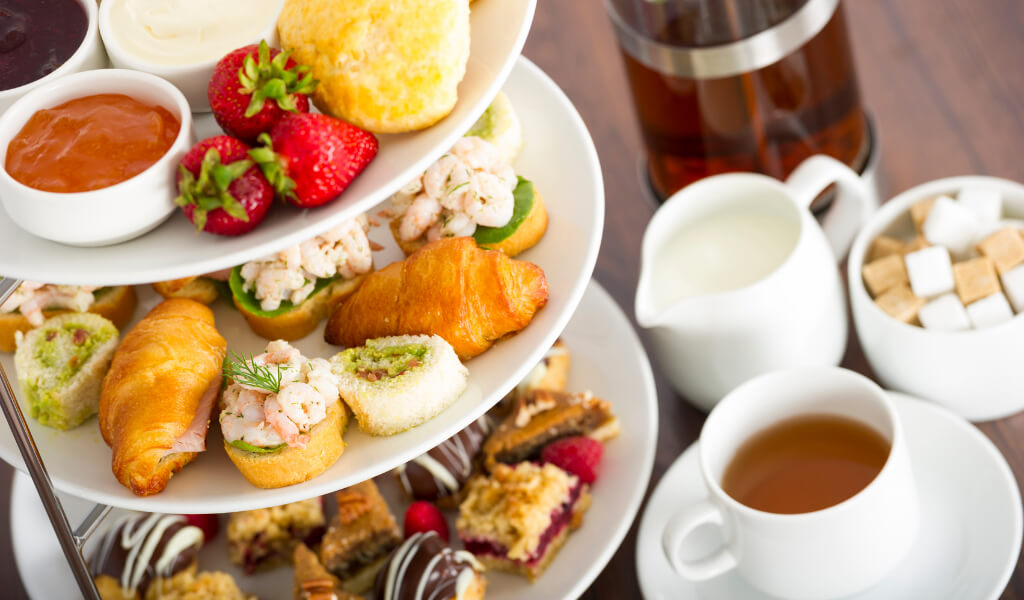
In the early 19th century, afternoon tea, or low tea, originated thanks to Anna, the Duchess of Bedford, who introduced it to curb afternoon hunger, not as a dinner substitute. Over time, it has evolved from a snack into a cherished culinary experience, highlighting British cuisine. While the tradition remains consistent, regional variations contribute local flair.
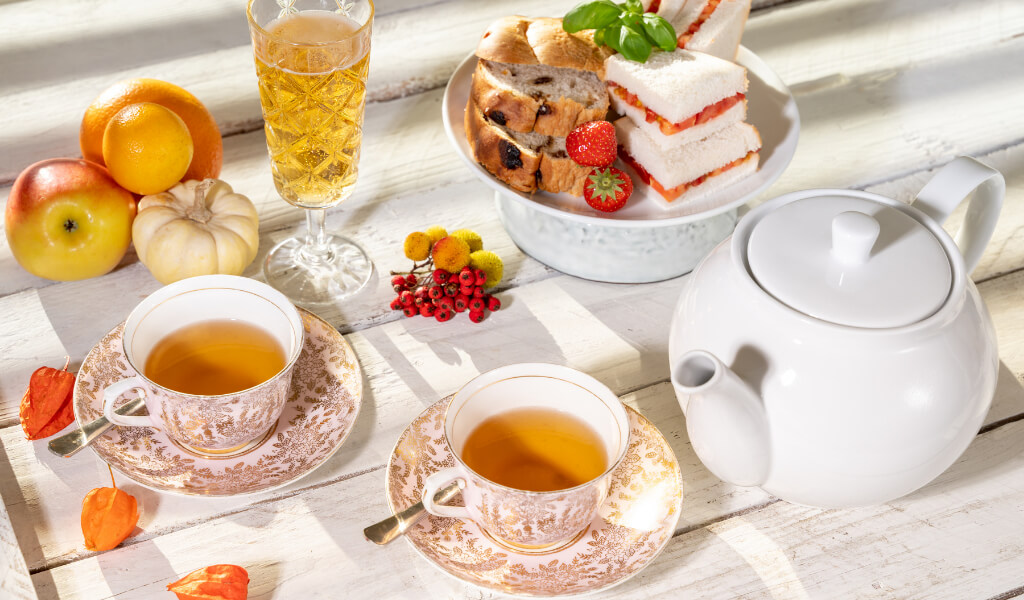
Now, if you’re wondering about the timing for afternoon british tea, it’s generally around 4 p.m. This aligns perfectly with our body’s natural rhythm, creating an ideal moment of relaxation and indulgence.
A typical hi-tea starts with finger sandwiches, moves on to scones with clotted cream and jam, and ends with pastries and cakes, all accompanied by carefully chosen tea. There are also variations like “Cream Tea” with scones, jam, and cream, or a fancier option known as “Champagne Afternoon Tea.”
Modern afternoon high time tea has embraced dietary preferences and trends, including vegan or gluten-free choices. Iconic establishments like London’s Ritz or the timeless Bettys Tea Rooms in Yorkshire are well known for their afternoon tea, often requiring reservations well in advance!

The enduring appeal of afternoon tea is its unique blend of culinary tradition and adaptable sophistication. It is an invitation to momentarily step back from the rush of daily life, appreciating the tranquility of a pot of tea and a plate of treats.
Read More:
Afternoon Tea vs. High Tea – What Are The Main Differences?
Take a look at the brief comparison table below that I’ve put together:
| High Tea | Afternoon Tea | |
| Defining Characteristics | Often known as “meat tea”, it served as a satisfying meal for the working classes. |
Also called “low tea”, it began as a leisure activity for the upper classes. |
| Typically served around 5 p.m. or 6 p.m., closer to dinner time. | Served mid-afternoon, around 4 p.m. | |
| Menu | A robust menu includes a hearty, often hot meal, baked goods, and strong tea. |
A light selection of finger sandwiches, scones, and sweet pastries paired with tea. |
| Originally a worker’s meal was served at high dining tables. | A social event for the upper classes enjoyed in comfortable lounge settings. | |
| Role in British Tradition | Resonates with practicality and sustenance, tied to the rhythm of industrial Britain. |
Reflects a genteel, leisurely pace, an event more than a meal. |
I recommend you discover the interesting things behind the difference in the content below:
High Tea vs Afternoon Tea – Defining Characteristics
Despite both being quintessential British customs involving tea, the defining characteristic of high tea and afternoon tea lies in their purpose and composition. The afternoon High tea, or “meat tea“, emerged as a fulfilling meal for the working classes, whereas afternoon tea, often termed “low tea“, started as a leisurely activity for the upper classes.
When is Tea Time
The afternoon teatime, or the timing of these traditions, forms another significant distinction. Afternoon tea, as the name suggests, is typically enjoyed in the mid-afternoon, around 4 p.m., whereas high tea aligns with the workers’ end of the day, typically around 5 p.m. or 6 p.m., closer to our understanding of dinner time.
The Disparity in Menus
The menu disparity between afternoon tea and high tea is striking. Afternoon tea usually includes light bites like finger sandwiches, scones, and sweet pastries, paired with a pot of tea. On the other hand, high tea features a more robust menu, combining a hearty, often hot meal with baked goods and strong tea.
High Tea Afternoon – The Contrast in Settings and Social Status
Afternoon tea was favored by the upper class in elegant lounges, while high tea, hence the name, was a working-class meal at tall tables. Although class distinctions have softened, these origins still influence today’s tea traditions.
English Tea Time
So, what time is tea time in England? Traditional British afternoon tea and high tea, both facets of English tea time, differ in their origins, ambiance, and evolution. Afternoon tea reflects a genteel, leisurely pace, an event more than a meal, while high tea resonates with practicality and sustenance, historically tied to the rhythm of industrial Britain. These traditions continue contributing to the rich tapestry of British culture and cuisine.
Read More:
The Different Types of Afternoon Tea
Traditional Afternoon Tea
Traditional Afternoon Tea is the classic experience most people associate with this British custom. It typically includes a selection of sandwiches, freshly baked scones with clotted cream and jam, followed by an array of cakes and pastries. All are served with a choice of teas.
Champagne Afternoon Tea
A luxurious spin on the classic Champagne Afternoon Tea takes your experience up a notch by offering a glass of Champagne in addition to the traditional tea spread. Perfect for celebrations or adding a touch of sparkle to your afternoon.
Cream Tea
Cream Tea is a simpler version of afternoon tea. It generally includes scones served with clotted cream, strawberry jam, and a tea pot. This offering is usually smaller and less formal than the traditional afternoon tea.
Savory Afternoon Tea
While traditional afternoon tea leans toward sweet treats, Savory Afternoon Tea focuses on hearty, savory items. Sandwiches and savory pastries take center stage, making it an ideal choice for those with less sweet tooth.
Vegan or Gluten-free Afternoon Tea
Many tea houses now offer Vegan or Gluten-free Afternoon Tea options in line with dietary preferences or needs. These ensure everyone can enjoy the afternoon tea experience without compromising taste or variety.
Themed Afternoon Tea
Themed Afternoon Teas are becoming increasingly popular, adding a fun twist to the traditional experience. Themes can range from favorite books, TV shows, or seasonal events, making each experience unique.
Read More:
Best Places for High Tea and Afternoon Tea in Britain
I’ve been fortunate to experience tea culture across Britain, and some places are just too good not to share.
If you’re in London, it’s worth booking ahead to enjoy the iconic afternoon tea at The Ritz or Claridge’s. Rules, London’s oldest restaurant, offers a traditional British experience for high tea.
When in Yorkshire, I highly recommend visiting Bettys Tea Rooms in Harrogate, a place frozen in time since 1919, offering a nostalgic afternoon tea experience.
Lastly, take advantage of the Balmoral Hotel in Edinburgh, Scotland, where you can experience a traditional high tea with a stunning view of Edinburgh Castle.
Afternoon tea today
Statistics confirm the rise: Google Trends reports a 70% surge in searches for “afternoon tea near me” in the past five years, indicating a strong revival of this timeless tradition. Afternoon tea is now a vibrant part of contemporary culture, not just a historical reference.
In the hustle of today’s world, afternoon tea has transformed from a “quick snack” to an indulgent pause in our busy routines.
Despite our fast-paced lifestyles, we often crave these small oases of relaxation and comfort.
Afternoon tea now represents time spent in charming settings, like Brigit’s Bakery in Covent Garden, savoring delectable treats and engaging in heartwarming conversations with loved ones.
Moreover, it has become more than a personal indulgence; it has become a way to commemorate special occasions. Whether it’s a milestone birthday, an anniversary, a corporate event, or simply making a trip to London memorable, afternoon tea has woven itself into the fabric of our celebrations.
High Tea in Scotland
In Scotland, afternoon tea is further differentiated. Scottish afternoon tea is not different from afternoon tea but includes hot food such as cheese on toast or other savory items.
Conclusion
And there you have it, my tea enthusiasts – a delightful dive into the captivating world of “high tea vs afternoon tea.”
Our journey together has brewed new insights and understanding about these two cherished British traditions. Whether the hearty high tea after a long day’s work or a luxurious afternoon tea enjoyed in a tranquil setting, each offers its unique blend of tradition, taste, and togetherness.
If you’ve enjoyed this post, please share it with fellow tea lovers. Your support helps keep the kettle boiling for future tea adventures. Thank you for joining me, and until next time, keep savoring those special tea moments.
FAQs
What do you do at a high tea?
At a high tea, you enjoy a substantial meal often composed of meats, cheeses, pies, and strong tea while seated at high dining tables. It’s a time to relax, replenish, and enjoy hearty food and good company.
What is high tea vs low tea vs afternoon tea?
High tea is a substantial, early dinner-type meal served with tea. Low tea, another name for afternoon tea, is a lighter meal with sandwiches, pastries, and teas enjoyed in the afternoon on low, comfortable furniture.
What are the three types of afternoon tea?
The three types of afternoon tea are traditional afternoon tea, cream tea, and champagne afternoon tea. Each varies slightly in its offerings, with the cream tea focusing on scones and the champagne afternoon tea adding an element of celebration with a glass of champagne.
Why is afternoon tea so popular?
Afternoon tea is popular for its combination of delicate food, fine tea, and the opportunity for socializing. It’s also cherished for its tradition, offering a taste of quintessential British culture.
What is the difference between English morning and afternoon tea?
English morning tea is typically a simple affair with a cup of tea and a light snack. On the other hand, afternoon tea is a more elaborate meal served in the afternoon with a selection of sandwiches, pastries, and scones.
Why is tea time so important in England?
Tea time is important in England as it’s deeply woven into British culture. Whether it’s the morning tea to kickstart the day, the traditional afternoon tea for socialization, or the high tea as a hearty end-of-day meal, each serves a significant role.
Image for High tea vs Afternoon tea
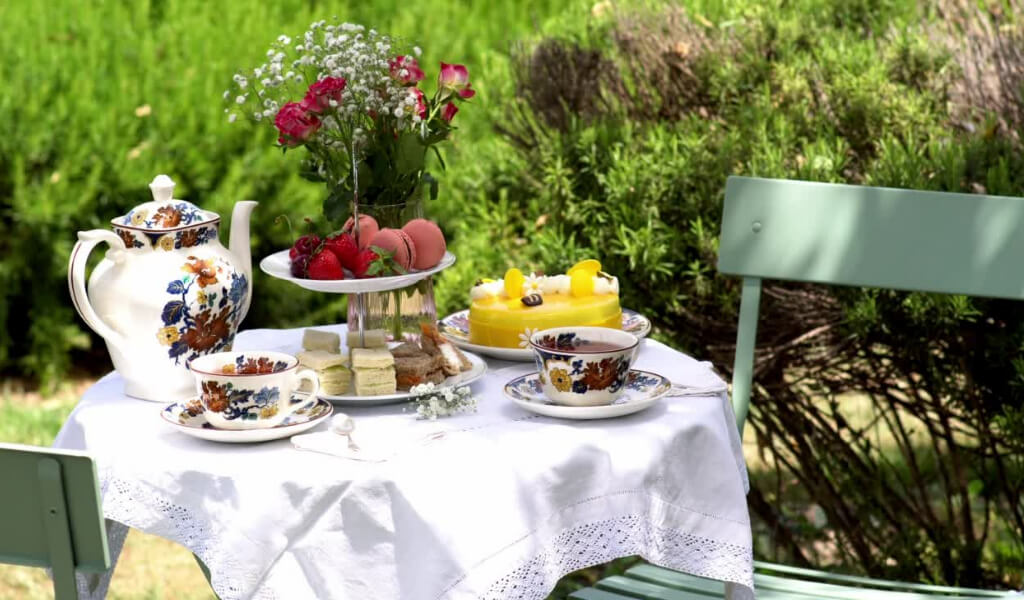


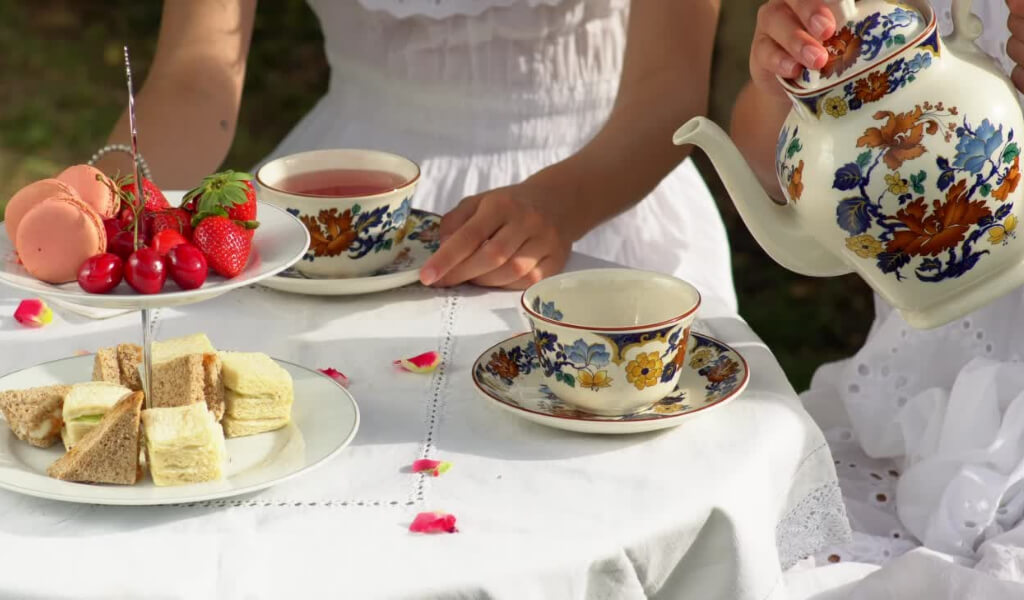





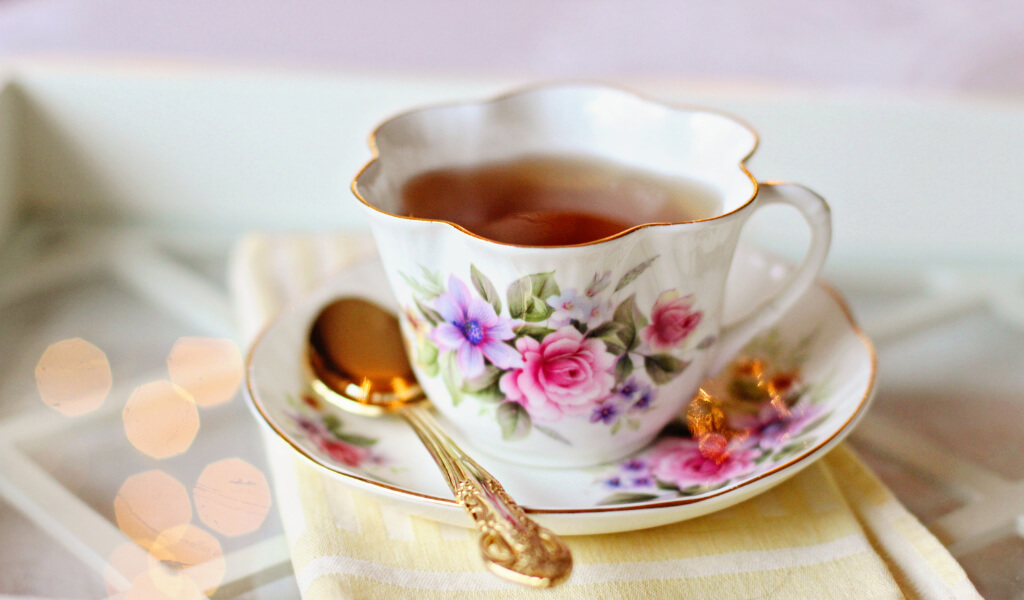





I’m Shanna, creator of Spiritea Drinks. I’m all about teaching people to grow their own food, tea, cook what they harvest, and eat with the seasons.



